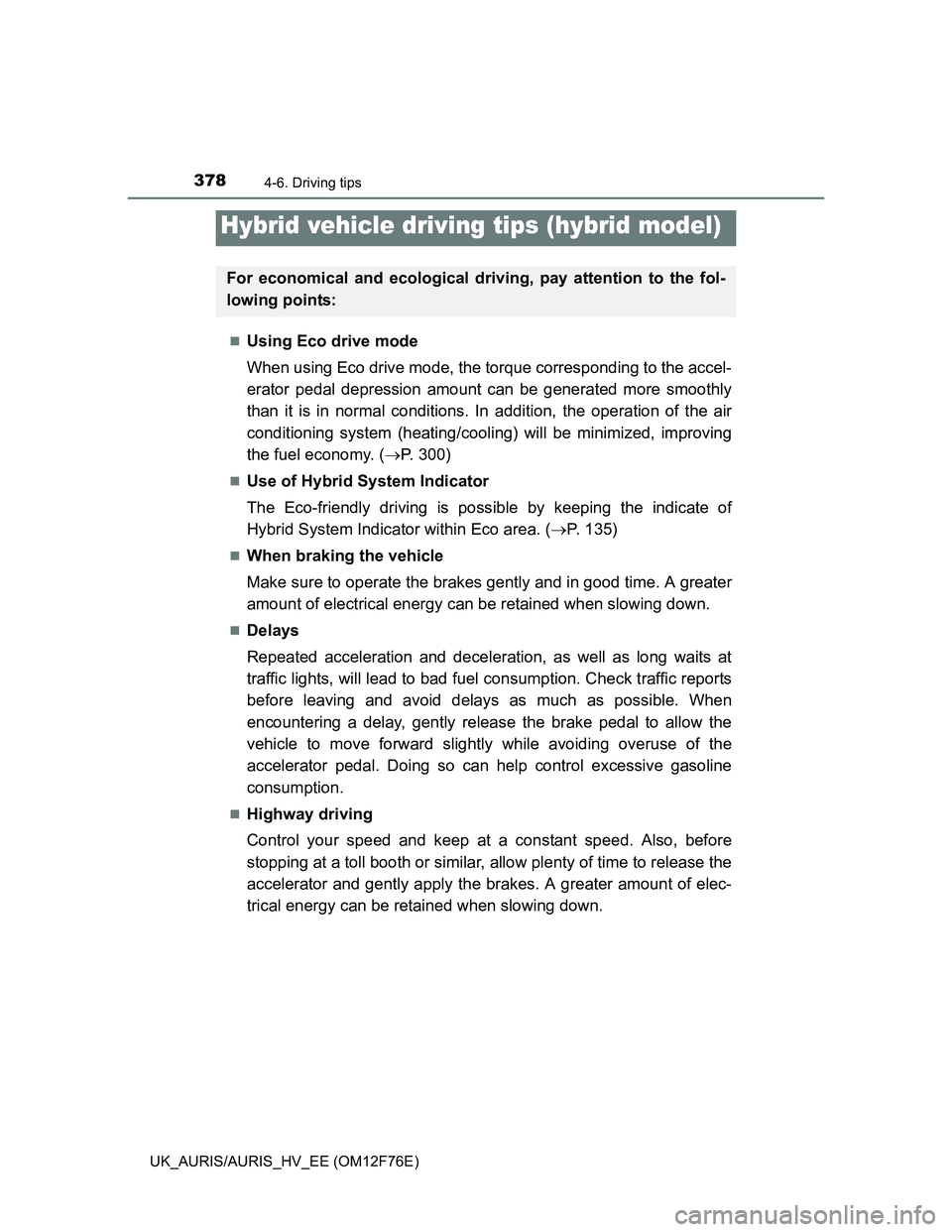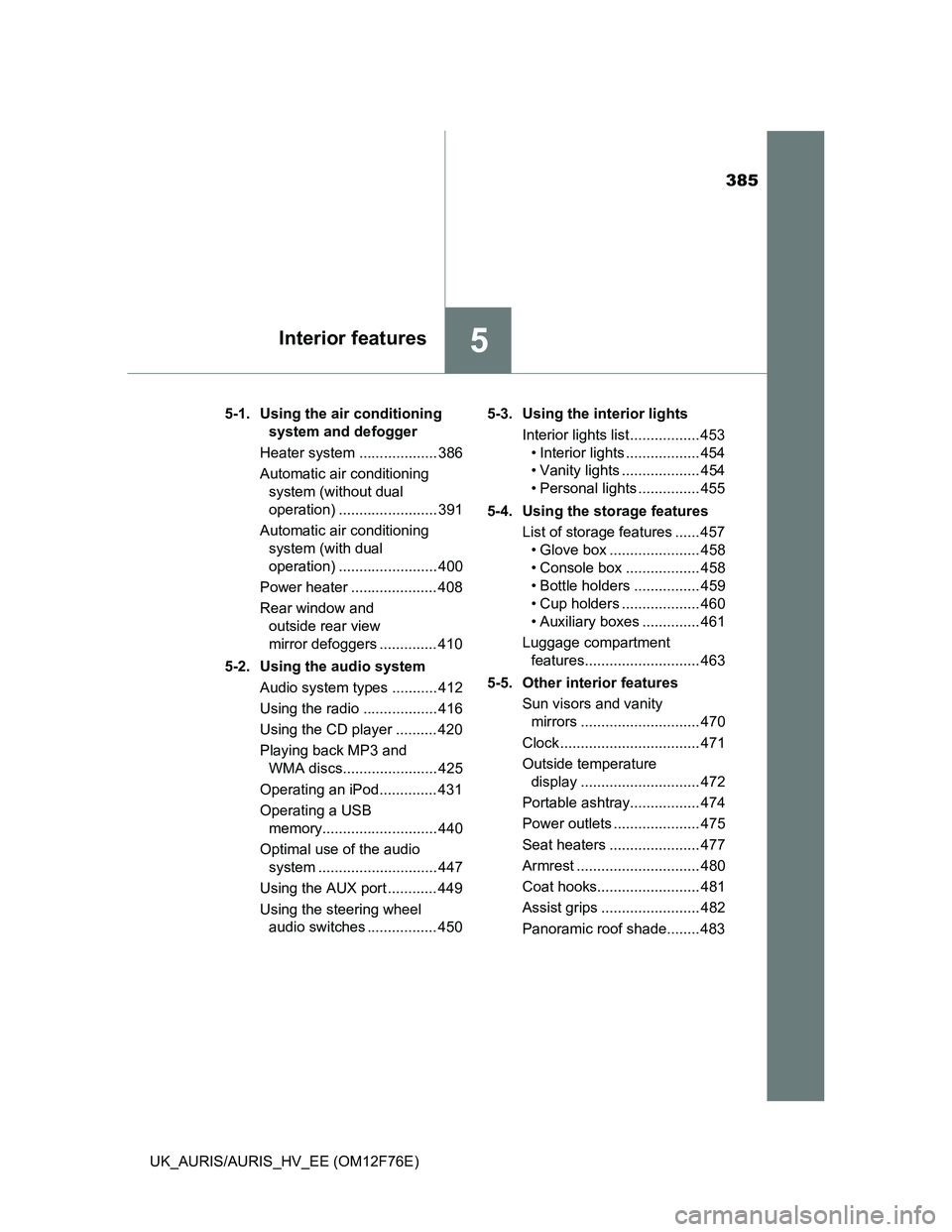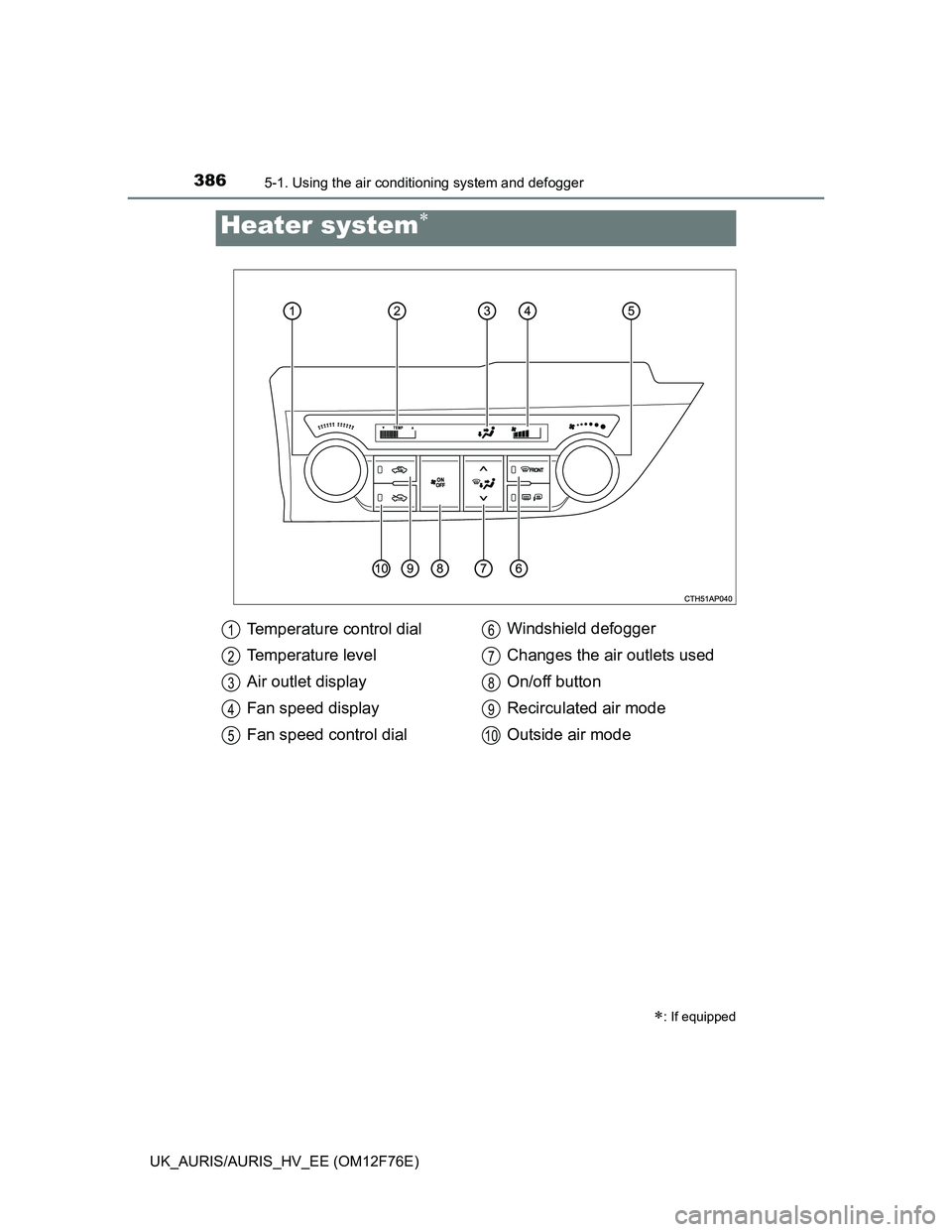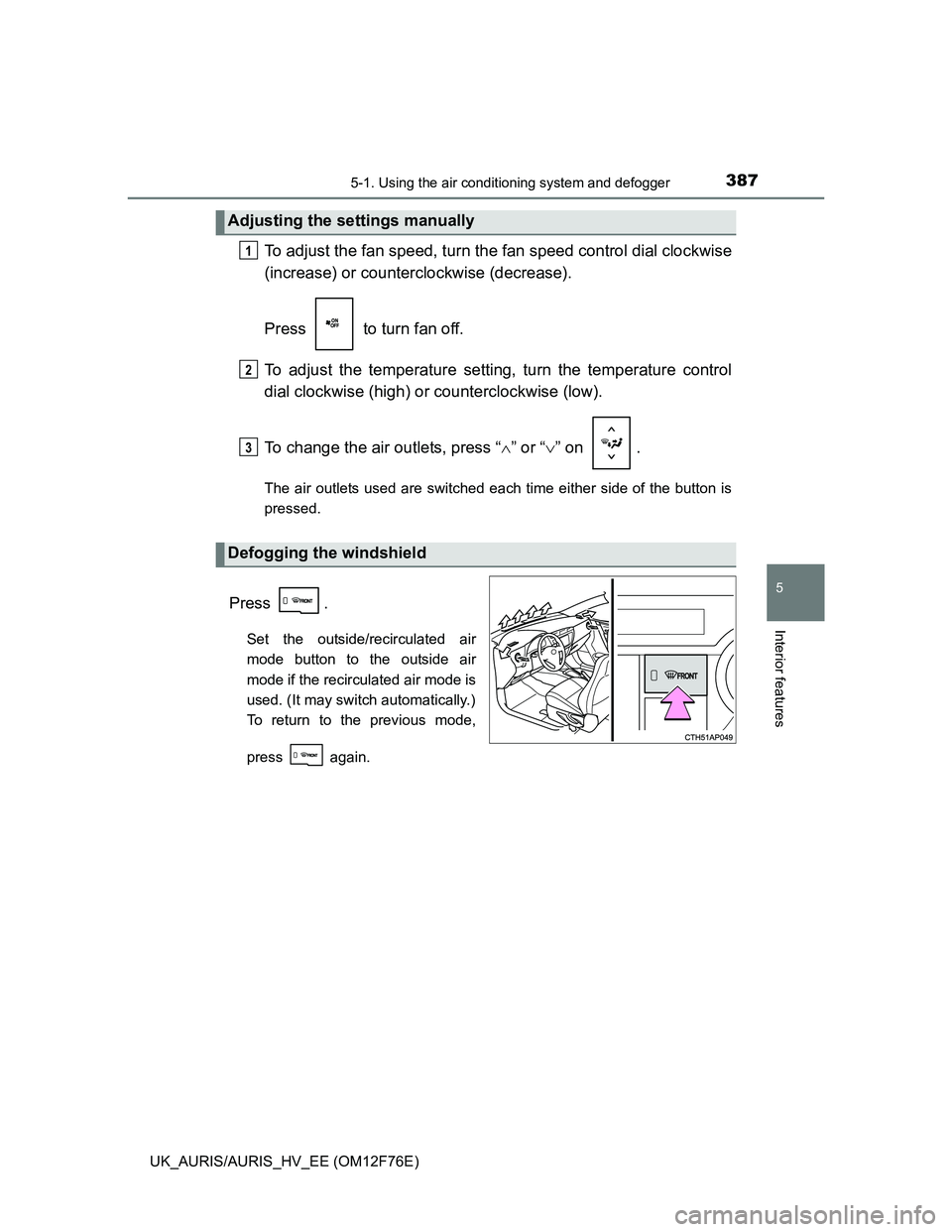2013 TOYOTA AURIS HYBRID air conditioning
[x] Cancel search: air conditioningPage 260 of 768

2604-1. Before driving
UK_AURIS/AURIS_HV_EE (OM12F76E)
Sudden acceleration/steering input/cornering
Executing sharp turns when towing may result in the trailer colliding
with your vehicle. Decelerate well in advance when approaching
turns and take them slowly and carefully to avoid sudden braking.
Important points regarding turning
The wheels of the trailer will travel closer to the inside of the curve
than the wheels of the vehicle. To make allowance for this, take the
turns wider than you would normally do.
Important points regarding stability
Vehicle movement resulting from uneven road surfaces and strong
crosswinds will affect handling. The vehicle may also be rocked by
passing buses or large trucks. Frequently check behind when mov-
ing alongside such vehicles. As soon as such vehicle movement
occurs, immediately start to decelerate smoothly by slowly applying
the brakes. Always steer the vehicle straight ahead while braking.
Passing other vehicles
Consider the total combined length of your vehicle and trailer and
ensure that the vehicle-to-vehicle distance is sufficient before exe-
cuting lane changes.
Transmission information
To maintain engine braking efficiency and charging system perfor-
mance when using engine braking, do not use the transmission in
D. Shift the shift position to B.
If the engine overheats
Towing a loaded trailer up a long, steep incline in temperatures
exceeding 30C (85F) may result in the engine overheating. If the
engine coolant temperature gauge indicates that the engine is over-
heating, turn the air conditioning off immediately, leave the road and
stop the vehicle in a safe place. (P. 680)
When parking the vehicle
Always place wheel chocks under the wheels of both the vehicle
and trailer. Firmly set the parking brake and shift the shift position to
P.
Page 364 of 768

3644-5. Using the driving support systems
UK_AURIS/AURIS_HV_EE (OM12F76E)
Operating conditions
The Stop & Start system is operational when all of the following conditions
are met:
• The engine is adequately warmed up.
• The 12-volt battery is sufficiently charged.
• The driver's door is closed.
• The driver's seat belt is fastened.
• The hood is closed.
• The clutch pedal is not being depressed.
• The shift lever is in N.
In the following circumstances the engine may not be stopped by the Stop &
Start system. This is not a malfunction of the Stop & Start system.
• Engine coolant temperature is too low or too high.
• Diesel engine: The outside temperature is too low.
• Vehicles with an automatic air conditioning system: The air conditioning
system is being used when the vehicle interior temperature is extremely
high such as after the vehicle was parked under the hot sun.
• Vehicles with an automatic air conditioning system only: The windshield
defogger is being used.
• Vehicles with a power heater: The power heater is being used.
• The 12-volt battery is not sufficiently charged, or is undergoing a peri-
odic recharge.
• Due to traffic or other circumstances the vehicle is stopped repeatedly,
resulting in the amount of time the engine is stopped by the Stop & Start
system to become excessively high.
• The brake booster vacuum is low.
• A large amount of electricity is being used.
• At high altitude
When the above conditions improve, the Stop & Start system will stop and
restart the engine from the next time the vehicle is stopped.
In the following situations, it may take longer than normal for the Stop & Start
system to activate.
• The 12-volt battery is discharged.
• After the 12-volt battery terminals have been disconnected and recon-
nected after a 12-volt battery replacement, etc.
• The engine coolant temperature is low.
Page 365 of 768

3654-5. Using the driving support systems
UK_AURIS/AURIS_HV_EE (OM12F76E)
4
Driving
Automatic engine start function
In the following situations, the engine may start even without the clutch pedal
being depressed.
• The brake pedal is pumped or strongly depressed.
• Vehicles with an automatic air conditioning system: The air conditioning
system is being used or turned on.
• Vehicles with an automatic air conditioning system only: The windshield
defogger is turned on.
• The 12-volt battery is not sufficiently charged.
• The vehicle starts to roll on an incline.
• A large amount of electricity is being used.
• The driver’s door is opened.
• The driver’s seat belt is unfastened.
Automatic reactivation of the Stop & Start system
Vehicles without a smart entry & start system: Even if the Stop & Start system
is disabled by the Stop & Start cancel switch, it will be automatically re-
enabled once the engine switch is turned to the “LOCK” position then to the
“START” position.
Vehicles with a smart entry & start system: Even if the Stop & Start system is
disabled by the Stop & Start cancel switch, it will be automatically re-enabled
once the engine switch is turned off then the engine is started.
The Stop & Start system protection feature
Vehicles without a smart entry & start system: When an excessively loud
sound is being projected by the audio system, the audio system may be auto-
matically cut off in order to maintain power for the Stop & Start system func-
tion.
If this occurs, turning the engine switch to the “LOCK” position then to the
“ACC” or “ON” position re-enables the audio system.
Vehicles with a smart entry & start system: When an excessively loud sound
is being projected by the audio system, the audio system may be automati-
cally cut off in order to maintain power for the Stop & Start system function.
If this occurs, turning the engine switch off then to ACCESSORY mode or
IGNITION ON mode re-enables the audio system.
Steering wheel operation
When the engine is stopped by the Stop & Start system, the steering wheel
may become heavier than when driving.
Hood
If the hood is opened while the engine is stopped by the Stop & Start system,
the engine cannot be restarted by the Stop & Start system or by the automatic
engine start function. Restart the engine with the engine switch operation.
(P. 262, 266)
Page 378 of 768

378
UK_AURIS/AURIS_HV_EE (OM12F76E)
4-6. Driving tips
Using Eco drive mode
When using Eco drive mode, the torque corresponding to the accel-
erator pedal depression amount can be generated more smoothly
than it is in normal conditions. In addition, the operation of the air
conditioning system (heating/cooling) will be minimized, improving
the fuel economy. (P. 300)
Use of Hybrid System Indicator
The Eco-friendly driving is possible by keeping the indicate of
Hybrid System Indicator within Eco area. (P. 135)
When braking the vehicle
Make sure to operate the brakes gently and in good time. A greater
amount of electrical energy can be retained when slowing down.
Delays
Repeated acceleration and deceleration, as well as long waits at
traffic lights, will lead to bad fuel consumption. Check traffic reports
before leaving and avoid delays as much as possible. When
encountering a delay, gently release the brake pedal to allow the
vehicle to move forward slightly while avoiding overuse of the
accelerator pedal. Doing so can help control excessive gasoline
consumption.
Highway driving
Control your speed and keep at a constant speed. Also, before
stopping at a toll booth or similar, allow plenty of time to release the
accelerator and gently apply the brakes. A greater amount of elec-
trical energy can be retained when slowing down.
Hybrid vehicle driving tips (hybrid model)
For economical and ecological driving, pay attention to the fol-
lowing points:
Page 379 of 768

3794-6. Driving tips
UK_AURIS/AURIS_HV_EE (OM12F76E)
4
Driving
Air conditioning
Use the air conditioning only when necessary. Doing so can help
control excessive gasoline consumption.
In summer: In high temperatures, use the recirculated air mode.
Doing so will help to reduce the burden on the air conditioner and
reduce fuel consumption as well.
In winter: Because the gasoline engine will not automatically cut out
until the gasoline engine and the interior of the vehicle are warm, it
will consume fuel. Also, fuel consumption can be improved by
avoiding overuse of the heater.
Checking tire inflation pressure
Make sure to check the tire inflation pressure frequently. Improper
tire inflation pressure can cause poor fuel consumption.
Also, as snow tires can cause large amounts of friction, their use on
dry roads can lead to poor fuel consumption. Use a tire that is
appropriate for the season.
Luggage
Carrying heavy luggage can lead to poor fuel consumption. Avoid
carrying unnecessary luggage. Installing a large roof rack can also
cause poor fuel consumption.
Warming up before driving
Since the gasoline engine starts up and cuts out automatically
when cold, warming up the engine is unnecessary. Moreover, fre-
quently driving short distances will cause the engine to repeatedly
warm up, which can lead to poor fuel consumption.
Page 385 of 768

385
5Interior features
UK_AURIS/AURIS_HV_EE (OM12F76E)5-1. Using the air conditioning
system and defogger
Heater system ................... 386
Automatic air conditioning
system (without dual
operation) ........................ 391
Automatic air conditioning
system (with dual
operation) ........................ 400
Power heater ..................... 408
Rear window and
outside rear view
mirror defoggers .............. 410
5-2. Using the audio system
Audio system types ........... 412
Using the radio .................. 416
Using the CD player .......... 420
Playing back MP3 and
WMA discs....................... 425
Operating an iPod.............. 431
Operating a USB
memory............................ 440
Optimal use of the audio
system ............................. 447
Using the AUX port ............ 449
Using the steering wheel
audio switches ................. 4505-3. Using the interior lights
Interior lights list ................. 453
• Interior lights .................. 454
• Vanity lights ................... 454
• Personal lights ............... 455
5-4. Using the storage features
List of storage features ...... 457
• Glove box ...................... 458
• Console box .................. 458
• Bottle holders ................ 459
• Cup holders ................... 460
• Auxiliary boxes .............. 461
Luggage compartment
features............................ 463
5-5. Other interior features
Sun visors and vanity
mirrors ............................. 470
Clock .................................. 471
Outside temperature
display ............................. 472
Portable ashtray................. 474
Power outlets ..................... 475
Seat heaters ...................... 477
Armrest .............................. 480
Coat hooks......................... 481
Assist grips ........................ 482
Panoramic roof shade........ 483
Page 386 of 768

386
UK_AURIS/AURIS_HV_EE (OM12F76E)
5-1. Using the air conditioning system and defogger
Heater system
: If equipped
Temperature control dial
Temperature level
Air outlet display
Fan speed display
Fan speed control dialWindshield defogger
Changes the air outlets used
On/off button
Recirculated air mode
Outside air mode1
2
3
4
5
6
7
8
9
10
Page 387 of 768

3875-1. Using the air conditioning system and defogger
UK_AURIS/AURIS_HV_EE (OM12F76E)
5
Interior features
To adjust the fan speed, turn the fan speed control dial clockwise
(increase) or counterclockwise (decrease).
Press to turn fan off.
To adjust the temperature setting, turn the temperature control
dial clockwise (high) or counterclockwise (low).
To change the air outlets, press “” or “” on .
The air outlets used are switched each time either side of the button is
pressed.
Press .
Set the outside/recirculated air
mode button to the outside air
mode if the recirculated air mode is
used. (It may switch automatically.)
To return to the previous mode,
press again.
Adjusting the settings manually
Defogging the windshield
1
2
3